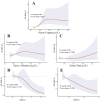The mediating role of inflammatory biomarkers in the association between serum copper and sarcopenia
- PMID: 39799188
- PMCID: PMC11724950
- DOI: 10.1038/s41598-024-84011-0
The mediating role of inflammatory biomarkers in the association between serum copper and sarcopenia
Abstract
This study aims to investigate the association between serum copper (Cu), selenium (Se), zinc (Zn), Se/Cu and Zn/Cu ratios and the risk of sarcopenia. In this study, which involved 2766 adults aged ≥ 20 years enrolled in the National Health and Nutrition Examination Survey (NHANES) from 2011 to 2016, multivariable logistic regression, restricted cubic spline (RCS) models and mediation analyses were used. After full adjustment, multivariable logistic regression revealed that higher serum copper levels were correlated with an increased risk of sarcopenia. Conversely, higher serum Se/Cu (OR 0.45, 95% CI 0.23-0.89, P = 0.023) and Zn/Cu (OR 0.49, 95% CI 0.27-0.90, P = 0.024) were associated with a decreased risk of sarcopenia. The RCS curve indicated a non-linear, roughly inverted L-shaped relationship between serum Cu and sarcopenia risk (P non-linear < 0.001). Additionally, Se/Cu (P non-linear = 0.179) and Zn/Cu (P non-linear = 0.786) showed negative linear associations with sarcopenia risk. Furthermore, white blood cell (WBC) count, neutrophil count, and systemic inflammation index (SII) were identified as significant mediators in the relationship between serum Cu and the risk of sarcopenia, with mediation proportions of 6.34%, 6.20%, and 4.37%, respectively (all P < 0.05). Therefore, balancing essential trace metals is crucial for maintaining muscle health.
Keywords: Copper; NHANES; Sarcopenia; Selenium; Zinc.
© 2024. The Author(s).
Conflict of interest statement
Declarations. Competing interests: The authors declare no competing interests.
Figures



Similar articles
-
Associations of serum zinc, copper, and selenium with sleep disorders in the American adults: Data from NHANES 2011-2016.J Affect Disord. 2023 Feb 15;323:378-385. doi: 10.1016/j.jad.2022.11.088. Epub 2022 Dec 2. J Affect Disord. 2023. PMID: 36464094
-
Association of Serum Concentrations of Copper, Selenium, and Zinc with Grip Strength Based on NHANES 2013-2014.Biol Trace Elem Res. 2024 Mar;202(3):824-834. doi: 10.1007/s12011-023-03718-9. Epub 2023 Jun 5. Biol Trace Elem Res. 2024. PMID: 37273075
-
Daily Intake and Serum Levels of Copper, Selenium and Zinc According to Glucose Metabolism: Cross-Sectional and Comparative Study.Nutrients. 2021 Nov 12;13(11):4044. doi: 10.3390/nu13114044. Nutrients. 2021. PMID: 34836302 Free PMC article.
-
Elevated Serum Copper, Zinc, Selenium, and Lowered α-Klotho Associations: Findings from NHANES 2011-2016 Dataset.Biol Trace Elem Res. 2025 Mar;203(3):1395-1404. doi: 10.1007/s12011-024-04282-6. Epub 2024 Jun 27. Biol Trace Elem Res. 2025. PMID: 38937385
-
The association between sedentary lifestyle and the prevalence of sarcopenia with the mediation role of systematic inflammation index, 25-hydroxyvitamin D, and testosterone: A nationwide cross-sectional study.Clin Nutr ESPEN. 2025 Apr;66:530-538. doi: 10.1016/j.clnesp.2025.02.022. Epub 2025 Feb 27. Clin Nutr ESPEN. 2025. PMID: 40023374
References
-
- Sieber, C. C. Malnutrition and sarcopenia. Aging Clin. Exp. Res.31, 793–798 (2019). - PubMed
-
- Güngör, Ö., Güzel, F. B., Ulu, S. & Zadeh, K. K. Sarcopenia in patients with chronic kidney disease. Turk. J. Nephrol.31, 3–6 (2022).
Publication types
MeSH terms
Substances
Grants and funding
- 823B2059/National Natural Science Foundation of China
- 2024CX142/Graduate Innovation Program of Jilin University
- U21A20390/Key Project of the National Natural Science Foundation of China
- 20230204075YY/Jilin Scientific and Technological Development Program
- 20240305034YY/Jilin Scientific and Technological Development Program
LinkOut - more resources
Full Text Sources

